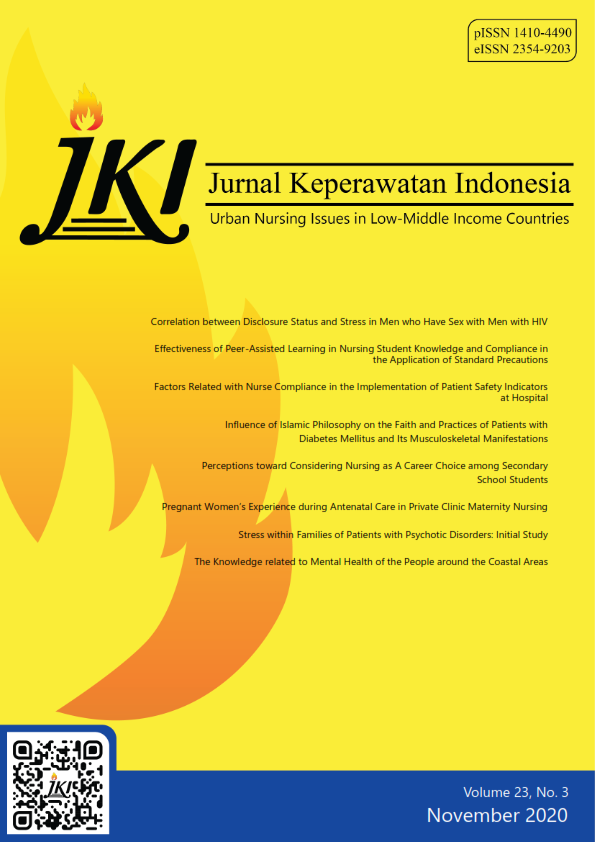Abstract
Demand for a nursing career in Malaysia has increased, although it has not been a popular course of choice among students. Understanding the perceptions of students about nursing may help identify any misconception toward the profession and their consideration to choose nursing as a career. This study aimed to identify the perceptions of secondary school students about nursing and their potential interest in joining a nursing career. A cross-sectional study using convenience sampling was conducted among 155 students by administering a High School Students Self-Administered Questionnaire from three selected secondary schools in Kuantan, Pahang Malaysia. Overall, the respondents positively perceived the nursing profession, although several parts were viewed negatively. Despite having a positive notion about nursing, only 18.1% of the respondents were interested to select nursing as their career and a majority of them were women. In conclusion, no significant difference in perceptions about nursing and consideration to choose nursing as a career was found. Nevertheless, the image of nurses and a nursing career need to be improved in the eye of students and
societies. In addition, the students were not aware of the benefits of nursing with several misconceptions of genders and doctor’s aid. Overall, the status of nursing in Malaysia should be enhanced to make it a valuable career.
Abstrak
Persepsi terhadap Mempertimbangkan Keperawatan sebagai Pilihan Karir di antara Siswa Sekolah Sekunder. Permintaan untuk karir keperawatan di Malaysia mengalami peningkatan, meskipun belum menjadi pilihan populer di kalangan siswa. Pemahaman mengenai persepsi siswa tentang keperawatan dapat membantu mengidentifikasi kesalahpahaman terhadap profesi dan pertimbangan mereka untuk memilih keperawatan sebagai karier. Penelitian ini bertujuan untuk mengidentifikasi persepsi siswa sekolah menengah tentang keperawatan dan potensi minat mereka untuk memilih karir keperawatan. Sebuah studi cross-sectional menggunakan convenience sampling dilakukan pada 155 siswa dengan High School Students Self-Administered Questionnaire dari tiga sekolah menengah di Kuantan, Pahang Malaysia. Secara keseluruhan, responden memandang positif profesi keperawatan, namun beberapa bagian dipandang negatif. Meskipun memiliki gagasan positif tentang keperawatan, hanya 18,1% dari responden tertarik untuk memilih keperawatan sebagai karir mereka dan mayoritas dari mereka adalah perempuan. Kesimpulannya, tidak ada perbedaan signifikan dalam persepsi tentang keperawatan dan pertimbangan untuk memilih keperawatan sebagai karier. Namun demikian, citra perawat dan karier keperawatan perlu ditingkatkan di mata siswa dan masyarakat. Selain itu, siswa tidak menyadari manfaat keperawatan dengan beberapa kesalahpahaman tentang gender dan bantuan dokter. Secara keseluruhan, status keperawatan di Malaysia harus ditingkatkan untuk menjadikannya karier yang berharga.
Kata Kunci: karier, keperawatan, persepsi, pilihan, sekolah menengah, siswa
References
- Al Kandari, F., & Ogundeyin, W. (1998). Patients and nurses’ perceptions of the quality of nursing care in Kuwait. Journal of Advanced Nursing, 27 (5), 914–921. https://doi.org/10.1046/j.1365-2648.1998.00047.x.
- Al-Mahmoud, S., & Mullen, P.M. (2013). The commitment of Saudi nursing students to nursing as a profession and as a career. Life Science Journal, 10 (2), 591–603. Retrieved from http://www.lifesciencesite.com/lsj/life1002/086_17742life1002_591_603.pdf.
- Aris, A., Sulaiman, S., & Hasan, M.K.C. (2019). The influence of music therapy on mental well-being among postoperative patients of
- total knee arthroplasty (TKA). Enfermeria Clinica, 29 (S2), 16–23. doi: 10.1016/j.enfcli.2019.04.004.
- Jan, A., & Sikander, S. (2012). Perceptions of high school students about nursing as a career. Rawal Medical Journal, 37 (1), 13–17. Retrieved from http://www.rmj.org.pk/?mno=11841.
- Keshk, L.I., Mersal, F.A., & Al Hosis, K.F. (2016). Preparatory students’ perception about the nursing profession and its impact on their career choice in Qassim University in KSA. American Journal of Nursing, 4 (3), 74–82. doi: 10.12691/ajnr-4-3-4.
- Lamadah, S.M., & Sayed, H.Y. (2014). Challenges facing nursing profession in Saudi Arabia. Journal of Biology, Agriculture and Healthcare, 4 (7), 20–25. Retrieved from https://core.ac.uk/download/pdf/234659818.pdf.
- Liaw, S.Y., Wu, L.T., Chow, Y.L., Lim, S., Tan, K.K. (2017). Career choice and perceptions of nursing among healthcare students in higher educational institutions. Nurse Education Today, 52, 66–72. doi: 10.1016/j.nedt.2017.02.008.
- Neilson, G.R., & Jones, M.C. (2012). What predicts the selection of nursing as a career choice in 5th and 6th year school students? Nurse Education Today, 32 (5), 588–593. doi: 10.1016/j.nedt.2011.06.011.
- Mkala, B. (2013). Nursing as a career: First year students’ perception of and the reasons for their choice of nursing as a career (Bachelor Thesis, Degree Programme in Nursing). Finlandia: JAMK University of Applied Sciences. Retrieved from https://www.theseus.fi/bitstream/handle/10024/70207/Thesis.pdf?sequence=1&isAllowed=y.
- Patidar A., Kaur J., Sharma S., Sharma, N. (2011). Future nurses' perception towards profession and carrier plans: A cross sectional survey in state Punjab. Nursing and Midwifery Research Journal, 7 (4), 175–185. http://doi.org/10.33698/NRF0131.
- Saad, S.M., Fatima, S.S., & Faruqi, A.A. (2011). Students' views regarding selecting medicine as a profession. Journal of the Pakistan Medical Association, 61 (8), 832–836. https://pubmed.ncbi.nlm.nih.gov/22356018/
- Sharif, N.A.M., Hasan, M.K.C., Jamaludin, F.I.C., & Firdaus, M.K.Z.H. (2018). The need for first aid education for adolescents. Enfermería Clínica, 28 (S1), 13–18. https://doi.org/10.1016/S1130-8621(18)30028-7.
- Tawash, E.A. (2016). Factors influencing the high school students' choice of a nursing career in Bahrain: Development of a best practice model for nursing recruitment. In proceeding 48th World Congress on Advanced Nursing Research, Ireland, 14–15 June 2018. Retrieved from https://www.omicsonline.org/conference-proceedings/advanced-nursing-research-2018-scientifictracks.digital/files/assets/basic-html/page-28.html.
- Williamson, C.L. (2012). Hispanic female undergraduates’ perception of nursing as a career choice: A phenomenological study (Doctoral dissertation, Health Administration). Arizona: University of Phoenix. Retrieved from https://search.proquest.com/docview/1151409623?pq-origsite=gscholar.
- World Health Organization. (2014). Global health workforce shortage to reach 12.9 million in coming decades. Retrieved from http://www. who.int/mediacentre/news/releases/2013/healthworkforceshortage/en/index.html.
- Wu, L.T., Low, M.M.J., Tan, K.K., López, V., & Liaw, S.Y. (2015). Why not nursing? A systematic review of factors influencing career choice among healthcare students. International nursing review, 62 (4), 547–562. doi: 10.1111/inr.12220.
- Yusoff, N.S.M., Firdaus, M.K.Z.H., Jamaludin, F.I.C., & Hasan, M.K.C. (2019). The need for educating healthcare professionals regarding good musculoskeletal health practice. Enfermeria Clinica, 29 (S2), 579–584. doi: 10.1016/j.enfcli.2019.04.089.
